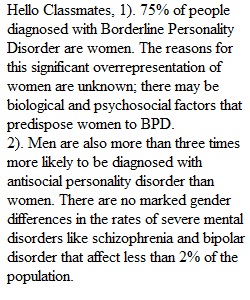


Q Personality disorders, like personality traits, are characterized by enduring patterns of behavior. Personality disorders, however, are inflexible and maladaptive. They impair personal or social functioning and are a source of distress to the individual or to other people. Paranoid Personality Disorder Schizoid Personality Disorder Schizotypal Personality Disorder Antisocial Personality Disorder Borderline Personality Disorder Avoidant Personality Disorder Supplemental film: Personality Disorders (Links to an external site.) Read the article 9% of a US community sample had a DSM-IV personality disorder Download 9% of a US community sample had a DSM-IV personality disorder, by Eaton and Bienvenu (2003). In a 250-300 word reply, answer the following questions: 1) Which personality disorders are diagnosed more in females? 2) Which personality disorder is more diagnosed in men? 3) What reason do the authors give for the gender differences seen in personality disorders? 4) The authors list several relationships that personality disorders have with things such as divorce, high school dropout, etc. The authors ask if the personality disorders are contributing to the high rates of high school dropout, divorce, etc., or do these experiences contribute to the expression of the disorders. What do you think? Respond to at least two other students in 75-100 words. Note: Click the options button in the upper right corner to see the rubric for this exercise.
View Related Questions